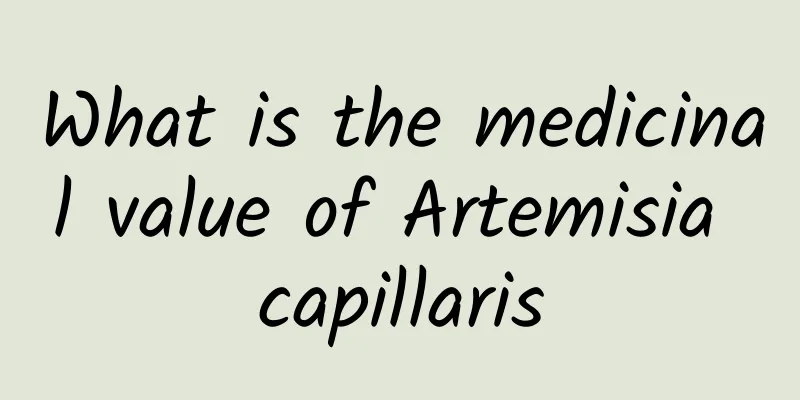What is the medicinal value of Artemisia capillaris

|
For female friends who often suffer from excessive menstrual bleeding, it is inevitable to see Artemisia capillaris in the drug ingredient instructions of the Chinese patent medicine prescribed by the doctor. Artemisia capillaris is a plant of the Asteraceae family and can be used as medicine. The most commonly manifested medicinal value is the treatment of gynecological diseases and respiratory diseases such as colds. In addition to this, what other medicinal values does Artemisia Capillaris have? Let’s learn more about it below. The whole plant can be used as medicine to prevent influenza, treat heatstroke, colds, headaches and heaviness, abdominal pain, vomiting, chest fullness, qi obstruction and food stagnation, abdominal distension due to food accumulation in children, diarrhea, menorrhagia, metrorrhagia, leucorrhea, skin itching and edema. Its heat dissipation and release function is better than that of mint. Clears away heat and dampness; reduces jaundice. Indications: jaundice, dysuria, itching of eczema, infectious icteric hepatitis, etc. Pharmacological studies have shown that it has the effects of promoting bile secretion, protecting liver function, relieving fever, anti-inflammatory, lowering blood lipids, and coronary dilation. Of course, this is only a study conducted by Western medicine on the extraction of Artemisia capillaris components, and it is difficult to judge its effectiveness in clinical applications. The toxicity of Chensu is central nervous system inhibition, manifested as drowsiness, salivation, etc. Excessive dosage of Artemisia capillaris can cause dizziness, nausea, diarrhea, upper abdominal discomfort, acute liver and gallbladder damage, and there are also reports of arrhythmia, but therapeutic doses of Artemisia capillaris generally do not cause serious damage. Artemisia capillaris has a significant liver-protecting effect and has significant therapeutic effects on hepatitis A, hepatitis B, and icteric hepatitis. It has a choleretic effect, promotes bile secretion, and increases the excretion of bile acid and bilirubin in bile. It can increase the blood flow of the coronary arteries of the heart, improve microcirculation, lower blood pressure, lower blood lipids, anti-coagulate, have diuretic, antipyretic and antiasthmatic effects, expel roundworms and inhibit a variety of pathogenic skin fungi and bacteria. I believe that after understanding it, everyone has recognized the medicinal value of Artemisia capillaris. Although Artemisia capillaris is a medicinal material that can be used to treat diseases, it is actually toxic. If you accidentally take an overdose of Artemisia capillaris, it may lead to death. So here I want to remind everyone that although Artemisia capillaris can be used as a medicine, you must never prepare it on your own. |
<<: What are the effects of soaking in water with Epimedium
>>: What is the medicinal value of the hawksbill turtle?
Recommend
Evodia rutaecarpa's efficacy and effects
Treating diseases also requires good medicines, w...
The efficacy and function of pearl hydrangea
Pearl hydrangea is a kind of traditional Chinese ...
The efficacy and function of chrysanthemum
Friends who don’t know about Huanghuangchao don’t...
The efficacy and function of cat's eye grass
Speaking of cat's eye grass, many people know...
The efficacy and function of red bean seven
Traditional Chinese medicine has a history of tho...
The efficacy and function of bamboo forest
The environment is now seriously deteriorating an...
New pattern of tourism economy and new orientation of industrial policy: On the tourism economic situation and summer consumption outlook in the first half of 2023
01. Economic upturn, market decline and strategic...
The efficacy and function of grasshopper lotus
Grass lily is a traditional Chinese medicine. In ...
Platform competition under the “full-term Double Eleven”
With the start of pre-sale on October 20, the bat...
National Fire Fighting Day丨Today, thank them!
The "Chongqing kids" who fight day and ...
Just observe the bubbles, this article will teach you how to become a wine connoisseur
Author: Deuterium The article comes from the Scie...
The efficacy and function of yellow back grass fruit
There are so many medicinal herbs in the world, a...
The explosion of the “hydrogen balloon” is horrifying, but middle school physics and chemistry knowledge tells you that hydrogen is not to blame!
On New Year's Eve, December 31, 2024, a video...
The efficacy and function of Zongba leaves
I don’t know if you are familiar with Zongba leav...
Effects and functions of Polygonatum odoratum
Polygonatum odoratum is called a fine product in ...









